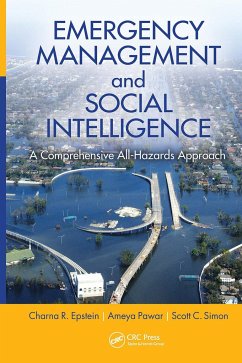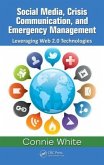Charna R Epstein, Ameya Pawar, Scott C Simon
Emergency Management and Social Intelligence
A Comprehensive All-Hazards Approach
Charna R Epstein, Ameya Pawar, Scott C Simon
Emergency Management and Social Intelligence
A Comprehensive All-Hazards Approach
- Gebundenes Buch
- Merkliste
- Auf die Merkliste
- Bewerten Bewerten
- Teilen
- Produkt teilen
- Produkterinnerung
- Produkterinnerung
For effective preparedness, emergency managers must comprehend how a disaster impacts not only the physical infrastructure of the affected community but also the population. They must understand how the people interact with one another, how they interact with government, and how they react to the disaster event. This text provides a comprehensive framework for understanding a community before, during, and after a disaster in order to best mitigate the effects on its people. It supplies emergency managers, policy makers, and elected officials with a powerful blueprint for implementing social intelligence in any community or organization.…mehr
Andere Kunden interessierten sich auch für
![A Futurist's Guide to Emergency Management A Futurist's Guide to Emergency Management]() Adam S CroweA Futurist's Guide to Emergency Management202,99 €
Adam S CroweA Futurist's Guide to Emergency Management202,99 €![Social Media, Crisis Communication, and Emergency Management Social Media, Crisis Communication, and Emergency Management]() Connie M WhiteSocial Media, Crisis Communication, and Emergency Management193,99 €
Connie M WhiteSocial Media, Crisis Communication, and Emergency Management193,99 €![Hurricane Mitigation for the Built Environment Hurricane Mitigation for the Built Environment]() Ricardo A AlvarezHurricane Mitigation for the Built Environment215,99 €
Ricardo A AlvarezHurricane Mitigation for the Built Environment215,99 €![Introduction to Homeland Defense and Defense Support of Civil Authorities (Dsca) Introduction to Homeland Defense and Defense Support of Civil Authorities (Dsca)]() Introduction to Homeland Defense and Defense Support of Civil Authorities (Dsca)167,99 €
Introduction to Homeland Defense and Defense Support of Civil Authorities (Dsca)167,99 €![Leadership in the Open Leadership in the Open]() Adam CroweLeadership in the Open202,99 €
Adam CroweLeadership in the Open202,99 €![Critical Infrastructure Critical Infrastructure]() Robert RadvanovskyCritical Infrastructure95,99 €
Robert RadvanovskyCritical Infrastructure95,99 €![Epidemic Risk Reduction Epidemic Risk Reduction]() Pawel GromekEpidemic Risk Reduction226,99 €
Pawel GromekEpidemic Risk Reduction226,99 €-
-
-
For effective preparedness, emergency managers must comprehend how a disaster impacts not only the physical infrastructure of the affected community but also the population. They must understand how the people interact with one another, how they interact with government, and how they react to the disaster event. This text provides a comprehensive framework for understanding a community before, during, and after a disaster in order to best mitigate the effects on its people. It supplies emergency managers, policy makers, and elected officials with a powerful blueprint for implementing social intelligence in any community or organization.
Hinweis: Dieser Artikel kann nur an eine deutsche Lieferadresse ausgeliefert werden.
Hinweis: Dieser Artikel kann nur an eine deutsche Lieferadresse ausgeliefert werden.
Produktdetails
- Produktdetails
- Verlag: Taylor & Francis
- Seitenzahl: 248
- Erscheinungstermin: 30. Dezember 2014
- Englisch
- Abmessung: 231mm x 155mm x 18mm
- Gewicht: 499g
- ISBN-13: 9781439847978
- ISBN-10: 1439847975
- Artikelnr.: 41625065
- Herstellerkennzeichnung
- Produktsicherheitsverantwortliche/r
- Europaallee 1
- 36244 Bad Hersfeld
- gpsr@libri.de
- Verlag: Taylor & Francis
- Seitenzahl: 248
- Erscheinungstermin: 30. Dezember 2014
- Englisch
- Abmessung: 231mm x 155mm x 18mm
- Gewicht: 499g
- ISBN-13: 9781439847978
- ISBN-10: 1439847975
- Artikelnr.: 41625065
- Herstellerkennzeichnung
- Produktsicherheitsverantwortliche/r
- Europaallee 1
- 36244 Bad Hersfeld
- gpsr@libri.de
Charna R. Epstein is the Chief Operating Officer at the University of Chicago Urban Education Institute (UEI). Prior to her work at UEI, Charna spent over ten years working in emergency and disaster management, primarily as the Director of Crisis Prevention, Resettlement and Disaster Recovery at Heartland Alliance for Human Needs and Human Rights. Charna also worked in Chicago government for three years and as a fellow at FEMA Region V. Among a number of awards, she was the recipient of the 2011 Red Cross Hero Award for disaster relief and preparedness work. Charna holds a M.Sc. in Threat and Response Management (2009), a M.A. in Social Service Administration (2005), both from the University of Chicago; and a B.A. from Brandeis University (1999). Ameya Pawar serves as the Alderman of the 47th Ward on the Chicago City Council. He was elected to office in 2011. Since taking office, Ameya has passed legislation creating an independent budget office for Chicago City Council, passed the nation's strongest anti-wage theft ordinance, and served on the Chicago Open 311 steering committee. Prior to taking office, Ameya spent 5 years working in emergency management and business continuity planning at Northwestern University. Ameya was a United States Department Scholar in 2009 and was named to Crain's Chicago Business 40 under 40 list in 2011. Ameya holds a M.Sc. in Threat and Response Management from the University of Chicago (2009) and a M.P.A. in Public Administration from the Illinois Institute of Technology (2007). Scott C. Simon works at BCFS Health and Human Services in the emergency management division in San Antonio, Texas. He holds a M.Sc. in Threat and Response Management from the University of Chicago (2009) and a B.A. from Texas State University (2007).
Emergency Management and the Need for Social Intelligence. What We Have-and
Haven't-Learned. Emergency Management Approach. Military/Paramilitary
Structures and Emergency Management. Situational Awareness. Situational
Awareness-Response and Recovery. Disaster Case Studies. Interplay between
Public Policy and Social Policy. The History of Disaster Relief and Social
Welfare Policy. Process of Declaring a Disaster-State Process and the
Stafford Act. Politics, Perception, Disaster, and Social Intelligence.
Perceptions of Poverty and Disaster. Perceptions, Reality, and Why We Care.
Social Intelligence Framework and Intelligence Methodology and Emergency
Management. Intelligence Methodology and Emergency Management.
Intelligence Methodology and Emergency Management. History of Intelligence.
History of U.S. Intelligence. Comprehensive Study-Geopolitical and
Socioeconomic Landscape. Intelligence in Action in Emergency Management.
Intelligence Cycle. Program and Policy Prescriptions. Implementing Social
Intelligence. Implementing the Intelligence Cycle in Emergency Management.
Real-Time Situational Awareness-Social Intelligence. Connecting the Dots.
Developing BDPs-Management Perspectives. Understand That Information Is
Currency for Emergency Management. Historical Analysis of Major Events.
Baseline Data Points. Drilling Down on Baseline Data Points.
Nongovernmental Entity BDPs. Corporate BDPs. Geographic Information Systems
and Modeling for Disaster. GIS Components. GISs in All Phases of Emergency
Management. GIS Modeling for Social Intelligence. Scenario-Based Planning.
Identifying Emerging Trends. Socializing Scenario-Based Planning into
Management Communications. Spatial Decision Support and GISs. Insurance
Industry and GIS Technology. Supply Chain Management and GIS. Social
Intelligence for Emergency Management: A New Paradigm. Hyperlocal Social
Intelligence. Block Clubs and Community Organizations. Religious and
Faith-Based Organizations. Chambers of Commerce. Local Historical Societies
and Museums. Local Post Offices and Banks. Think Locally, Act Globally.
Budgets and Disaster. Green Infrastructure. Investing in Vulnerable
Communities. Investing Pension Funds Locally. Zoning Policies. Open
Government-Open 311, Predictive Analytics, and BDPs to Inform Government
Decision Making. COAD/VOAD. Lessons Learned from Recent Events. Municipal
Credit Ratings. Unique Social Factors as a Result of Location or Size.
Public Transportation. Language Access, Cultural Competence, and Historical
Issues Related to Immigration.
Haven't-Learned. Emergency Management Approach. Military/Paramilitary
Structures and Emergency Management. Situational Awareness. Situational
Awareness-Response and Recovery. Disaster Case Studies. Interplay between
Public Policy and Social Policy. The History of Disaster Relief and Social
Welfare Policy. Process of Declaring a Disaster-State Process and the
Stafford Act. Politics, Perception, Disaster, and Social Intelligence.
Perceptions of Poverty and Disaster. Perceptions, Reality, and Why We Care.
Social Intelligence Framework and Intelligence Methodology and Emergency
Management. Intelligence Methodology and Emergency Management.
Intelligence Methodology and Emergency Management. History of Intelligence.
History of U.S. Intelligence. Comprehensive Study-Geopolitical and
Socioeconomic Landscape. Intelligence in Action in Emergency Management.
Intelligence Cycle. Program and Policy Prescriptions. Implementing Social
Intelligence. Implementing the Intelligence Cycle in Emergency Management.
Real-Time Situational Awareness-Social Intelligence. Connecting the Dots.
Developing BDPs-Management Perspectives. Understand That Information Is
Currency for Emergency Management. Historical Analysis of Major Events.
Baseline Data Points. Drilling Down on Baseline Data Points.
Nongovernmental Entity BDPs. Corporate BDPs. Geographic Information Systems
and Modeling for Disaster. GIS Components. GISs in All Phases of Emergency
Management. GIS Modeling for Social Intelligence. Scenario-Based Planning.
Identifying Emerging Trends. Socializing Scenario-Based Planning into
Management Communications. Spatial Decision Support and GISs. Insurance
Industry and GIS Technology. Supply Chain Management and GIS. Social
Intelligence for Emergency Management: A New Paradigm. Hyperlocal Social
Intelligence. Block Clubs and Community Organizations. Religious and
Faith-Based Organizations. Chambers of Commerce. Local Historical Societies
and Museums. Local Post Offices and Banks. Think Locally, Act Globally.
Budgets and Disaster. Green Infrastructure. Investing in Vulnerable
Communities. Investing Pension Funds Locally. Zoning Policies. Open
Government-Open 311, Predictive Analytics, and BDPs to Inform Government
Decision Making. COAD/VOAD. Lessons Learned from Recent Events. Municipal
Credit Ratings. Unique Social Factors as a Result of Location or Size.
Public Transportation. Language Access, Cultural Competence, and Historical
Issues Related to Immigration.
Emergency Management and the Need for Social Intelligence. What We Have-and
Haven't-Learned. Emergency Management Approach. Military/Paramilitary
Structures and Emergency Management. Situational Awareness. Situational
Awareness-Response and Recovery. Disaster Case Studies. Interplay between
Public Policy and Social Policy. The History of Disaster Relief and Social
Welfare Policy. Process of Declaring a Disaster-State Process and the
Stafford Act. Politics, Perception, Disaster, and Social Intelligence.
Perceptions of Poverty and Disaster. Perceptions, Reality, and Why We Care.
Social Intelligence Framework and Intelligence Methodology and Emergency
Management. Intelligence Methodology and Emergency Management.
Intelligence Methodology and Emergency Management. History of Intelligence.
History of U.S. Intelligence. Comprehensive Study-Geopolitical and
Socioeconomic Landscape. Intelligence in Action in Emergency Management.
Intelligence Cycle. Program and Policy Prescriptions. Implementing Social
Intelligence. Implementing the Intelligence Cycle in Emergency Management.
Real-Time Situational Awareness-Social Intelligence. Connecting the Dots.
Developing BDPs-Management Perspectives. Understand That Information Is
Currency for Emergency Management. Historical Analysis of Major Events.
Baseline Data Points. Drilling Down on Baseline Data Points.
Nongovernmental Entity BDPs. Corporate BDPs. Geographic Information Systems
and Modeling for Disaster. GIS Components. GISs in All Phases of Emergency
Management. GIS Modeling for Social Intelligence. Scenario-Based Planning.
Identifying Emerging Trends. Socializing Scenario-Based Planning into
Management Communications. Spatial Decision Support and GISs. Insurance
Industry and GIS Technology. Supply Chain Management and GIS. Social
Intelligence for Emergency Management: A New Paradigm. Hyperlocal Social
Intelligence. Block Clubs and Community Organizations. Religious and
Faith-Based Organizations. Chambers of Commerce. Local Historical Societies
and Museums. Local Post Offices and Banks. Think Locally, Act Globally.
Budgets and Disaster. Green Infrastructure. Investing in Vulnerable
Communities. Investing Pension Funds Locally. Zoning Policies. Open
Government-Open 311, Predictive Analytics, and BDPs to Inform Government
Decision Making. COAD/VOAD. Lessons Learned from Recent Events. Municipal
Credit Ratings. Unique Social Factors as a Result of Location or Size.
Public Transportation. Language Access, Cultural Competence, and Historical
Issues Related to Immigration.
Haven't-Learned. Emergency Management Approach. Military/Paramilitary
Structures and Emergency Management. Situational Awareness. Situational
Awareness-Response and Recovery. Disaster Case Studies. Interplay between
Public Policy and Social Policy. The History of Disaster Relief and Social
Welfare Policy. Process of Declaring a Disaster-State Process and the
Stafford Act. Politics, Perception, Disaster, and Social Intelligence.
Perceptions of Poverty and Disaster. Perceptions, Reality, and Why We Care.
Social Intelligence Framework and Intelligence Methodology and Emergency
Management. Intelligence Methodology and Emergency Management.
Intelligence Methodology and Emergency Management. History of Intelligence.
History of U.S. Intelligence. Comprehensive Study-Geopolitical and
Socioeconomic Landscape. Intelligence in Action in Emergency Management.
Intelligence Cycle. Program and Policy Prescriptions. Implementing Social
Intelligence. Implementing the Intelligence Cycle in Emergency Management.
Real-Time Situational Awareness-Social Intelligence. Connecting the Dots.
Developing BDPs-Management Perspectives. Understand That Information Is
Currency for Emergency Management. Historical Analysis of Major Events.
Baseline Data Points. Drilling Down on Baseline Data Points.
Nongovernmental Entity BDPs. Corporate BDPs. Geographic Information Systems
and Modeling for Disaster. GIS Components. GISs in All Phases of Emergency
Management. GIS Modeling for Social Intelligence. Scenario-Based Planning.
Identifying Emerging Trends. Socializing Scenario-Based Planning into
Management Communications. Spatial Decision Support and GISs. Insurance
Industry and GIS Technology. Supply Chain Management and GIS. Social
Intelligence for Emergency Management: A New Paradigm. Hyperlocal Social
Intelligence. Block Clubs and Community Organizations. Religious and
Faith-Based Organizations. Chambers of Commerce. Local Historical Societies
and Museums. Local Post Offices and Banks. Think Locally, Act Globally.
Budgets and Disaster. Green Infrastructure. Investing in Vulnerable
Communities. Investing Pension Funds Locally. Zoning Policies. Open
Government-Open 311, Predictive Analytics, and BDPs to Inform Government
Decision Making. COAD/VOAD. Lessons Learned from Recent Events. Municipal
Credit Ratings. Unique Social Factors as a Result of Location or Size.
Public Transportation. Language Access, Cultural Competence, and Historical
Issues Related to Immigration.








